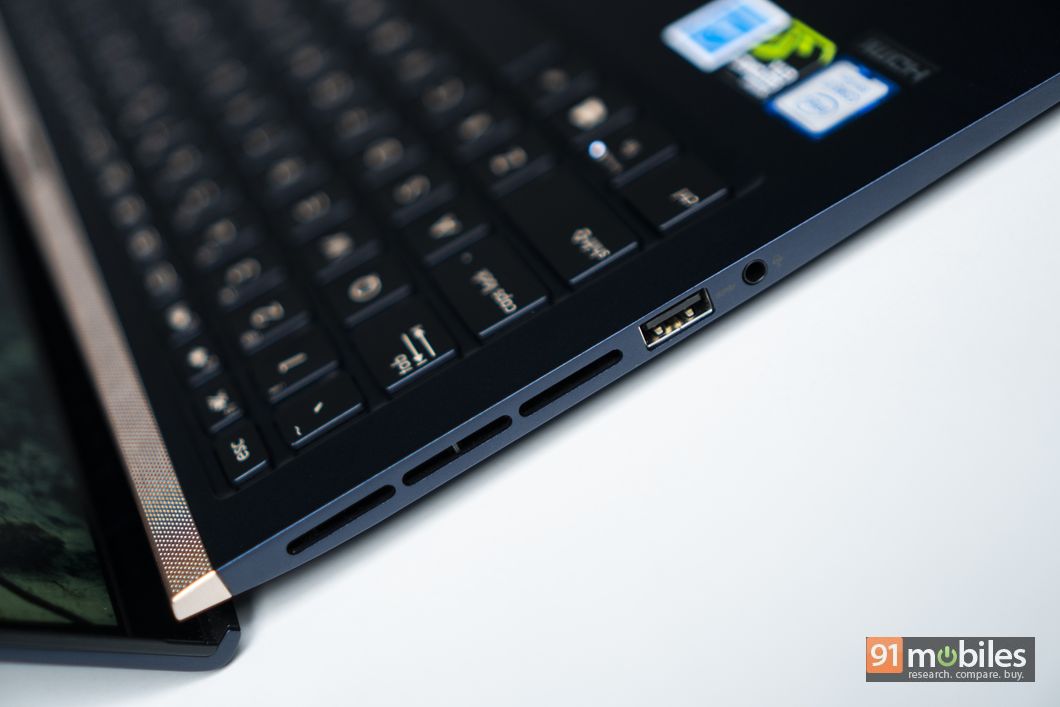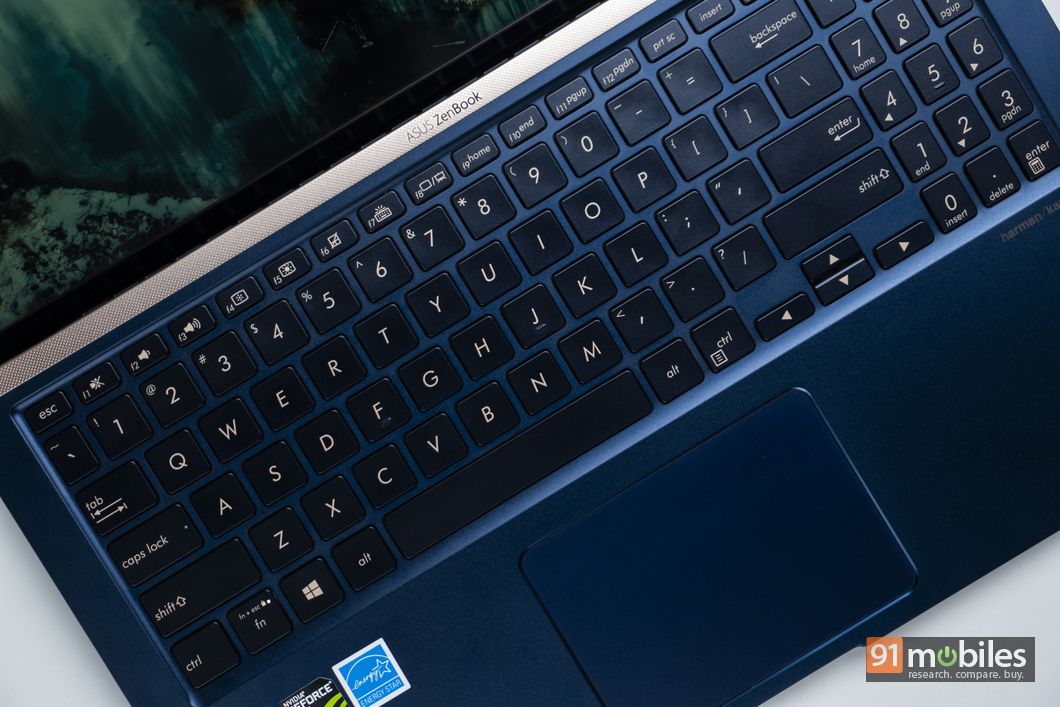“ASUS ZenBook 15 (UX533F) is one of the best-looking laptops in the market”
Of late, ASUS has shown that the brand is not afraid of taking risks and the ZenBook 15 Pro is a clear example of this approach. However, as you might imagine, implementing a design with dual displays on a laptop doesn’t just result in an attractive product, but also ends up digging a deep hole in the customer’s pocket. To avoid alienating the mainstream consumers in pursuit of the enthusiasts, the brand has another offering in line – the ZenBook 15 (UX533F) – which was unveiled at IFA 2018 late last year. Now that the laptop has made its way to India, we recently managed to get the hands on the device for the review and can now share our thoughts on the powerful new portable from ASUS. Without wasting any time, let’s jump into the review.

Table of Contents
Design and display
The ZenBook series of laptops from ASUS is known for sleek designs and the UX533F is no exception to this rule. However, with its new laptop, the brand has offered a polished product that looks minimalistic yet premium. The laptop’s sturdy metal body comes with a lid that features a circular metal pattern and ASUS branding right in the middle. There are no over-the-top elements here and you will notice that the company has paid attention to minute details. For example, the display hinge slides nicely beneath the keyboard in resting position to elevate the laptop’s body ever so slightly to maintain air flow and prevent heating issues.

Perhaps the most flashy element of the laptop is the gold-coloured strip, which is placed right above the keyboard with ‘ASUS ZenBook’ branding in the middle. The laptop is offered in Icicle Silver and Royal Blue colours, and on our review unit (which is the latter out of the two) the combination of royal blue and gold looked really classy and premium.

The laptop is fairly thin but the all-metal construction takes the weight of the chassis up to 1.59kg, which is still lighter than many of the other notebooks available in the market. If we talk about dimensions, the ZenBook 15 (UX533F) measures 35.4cmx22cmx1.79cm, which is a compact size for a laptop with reasonably large screen size. This means that you can carry around the new ZenBook easily in your backpack without any issues.

This brings us to the keyboard. On the ZenBook 13 model, the brand found an innovative way to include a numeric keypad by using the touchpad area as a multi-functional unit. Here, as there is more room to play around with, ASUS has included a proper numeric keypad on the right side of the keyboard, which is a rarity for laptops. You also get a secondary ‘Enter’ key, which can be useful at times.

The keys are well spaced out and you will face no issues with the palm rest space either. The keys on the laptop offer a 1.4mm key travel, which is not best in class but works just fine. If your job involves long sessions of writing, you will find typing to be a rather comfortable experience on the ZenBook 15 (UX533F). And just in case you’re concerned about typing in poor lighting conditions, the keyboard comes with three gradations for its backlight. We faced some responsiveness issues with the touchpad but they were not frequent enough to be a big issue.
Although the laptop comes with a MIL-STD 810G-certified body and feels sturdy, there is a noticeable weak spot that can be felt when the laptop is pressed around the palm rest area. Now, in everyday use, we did not find this to be an issue and unless you press the laptop body deliberately, this should not be an issue for you either, even in long term use.
 On the left side of the laptop, you’ll find the exhaust vents, alongside a USB 3.1 Type-A port and a 3.5mm headphone jack. On the right side of the laptop, there is a USB 3.1 Gen 2 Type-C port, a USB 3.1 Type-A port, an HDMI port, an SD card slot, and the charging port. As you can see, ASUS is not one of the brands that are ready to lose customers who need their connectivity options as a trade-off for slimmer form factors.
On the left side of the laptop, you’ll find the exhaust vents, alongside a USB 3.1 Type-A port and a 3.5mm headphone jack. On the right side of the laptop, there is a USB 3.1 Gen 2 Type-C port, a USB 3.1 Type-A port, an HDMI port, an SD card slot, and the charging port. As you can see, ASUS is not one of the brands that are ready to lose customers who need their connectivity options as a trade-off for slimmer form factors.

Let’s talk about the display. The 15.6-inch ‘NanoEdge’ display, as the branding suggests, comes with extremely thin bezels on all sides (by laptop standards). The top bezel features the webcam, which works well for video-conferencing as the video quality is decent. Our review unit came with a glossy finish on the panel with full HD resolution and definitely managed to grab our attention from the word go.

With the thin bezels, the display quality offered by the laptop looks really good and watching movies or music videos is a fun experience. However, if you compare the display right next to the 13-inch MacBook Pro (2017), the latter’s display appears more vibrant in general. This can be partly attributed to higher resolution display on the Apple laptop but as these products fall in same price category, we think the comparison is fair. Having said that, if you keep aside the comparisons, you will have no issues with the display on offer here. The text looks sharp and the large screen estate is a delight to work with. The glossy finish on the display panel does catch fingerprints when you adjust the viewing angles but also provides the laptop with a premium feel. As the panel is not a touchscreen, you won’t have to carry around a cleaning cloth at all times. On the downside, outdoor use is difficult as the display is extremely reflective. Here’s a close look at the portable:
Performance and audio
If we take modern needs into consideration, working professionals need their laptops to be extremely capable. Before going into detail, we would like to say up front that the ZenBook 15 (UX533F) gets the work done. To get the specifications out of the way, the premium segment portable from ASUS comes with a Whiskey Lake architecture-based Intel Core i7-8565U processor, with a base clock speed of 1.8GHz and a turbo frequency of up to 4.6GHz. The graphics needs on the laptop are handled by a GTX 1050 GPU with Nvidia’s Max-Q design, which is meant specifically for thin and quiet laptops, with 2GB of GDDR5 VRAM. To go along, there is 16GB of LPDDR4 RAM on board. Our review unit came with 1TB PCIe SSD storage.

The on-paper specifications work as a spoiler because ZenBook 15 (UX533F) handles most daily tasks like a champ. The laptop runs Windows 10 Home out of the box and the processing speeds are impressive in most use cases. There are some pre-installed ASUS apps but there are no standout additions to the operating system offered by Microsoft. To compensate for the lack of a fingerprint sensor, the company has included a 3D IR HD camera, which allows for facial recognition. We found the unlocking method to be extremely convenient and zippy in our testing, and also a capable substitute for a fingerprint sensor.
Thanks to the SSD, the loading times are never frustrating. To put the dedicated GPU to test, we played some demanding titles on the laptop, despite knowing that the UX533F is not a gaming-centric offering.

While playing PUBG at low graphics settings, the laptop managed to hit around 30 frames per second consistently. When these settings were bumped up to medium, the frames dropped well below 30 fps. The game was largely playable on low settings but definitely not on medium graphics settings as the frame drops impacted the gameplay drastically. We also played Apex Legends on the laptop and managed to get around 35 fps with most graphics settings at medium. If you want to play some old titles like Dirt 3 or want to play new games on low graphics settings, you should be fine with the laptop but if you want some serious gaming performance, ASUS’ new ZenBook is not meant for you.

Coming to the benchmarks, the ZenBook 15 (UX533F) scored 3535 on PCMark 10, which is a decent score but we expected the laptop to fair slightly better.

On Cinebench 15, the portable managed 100.08fps on OpenGL, which is a really good frame rate. Finally on CrystalDiskMark, the laptop and got average read speeds of 3,501.2mbps and average write speeds of 2,222.9mbps, which are both extremely impressive.

It is now time to turn to one of the most underwhelming aspects of the laptop. The ZenBook 15 (UX533F) comes with an ASUS SonicMaster stereo audio system with surround sound and Harmon Kardon branding. Before testing, we expected the laptop to offer brilliant sound but the audio offered by the ZenBook 15 (UX533F) feels flat. Sadly, this might be a concerning point for potential customers.
Battery life
The ZenBook 15 (UX533F) houses a 73Wh 4-cell Li-polymer battery. In regular use, we managed to get around a day’s backup from the laptop in regular use (without gaming), which is definitely impressive.

In BatteryEaterPro benchmark, the laptop lasted for around 10 hours and 28 minutes, which is one of the most impressive timings that we have recorded so far. Needless to say, you will not have any issues with the battery backup offered by the laptop.

In case you like to play games, the battery backup offered by the laptop might drop by a few hours. The laptop comes with a 90W power adapter, which effectively means it doesn’t take ages to charge as well.
Verdict
To conclude, The ZenBook 15 (UX533F) seems like an overall package. With this laptop, you get premium design, solid performance, and an immersive display. However, the audio performance offered by the laptop is underwhelming and the product seems to be a jack of all trades master of none. The pricing for the ZenBook 15 (UX533F) has been kept at Rs 1,39,990 by the company and in this range, customers can choose to buy anything from 13-inch Apple MacBook Pro to the Dell XPS 15 9570 (i7 variant). In conclusion, we can say that the ASUS ZenBook 15 (UX533F) is a compelling offering, but might not be everybody’s cup of tea as it still has issues in the audio department, and gamers will prefer portables with more powerful dedicated graphics hardware.
Editor’s rating: 4 / 5
Pros
- Brilliant design
- Powerful hardware
- Impressive battery life
Cons
- Audio performance
- Glossy display makes outdoor use difficult
Photos by Raj Rout



















